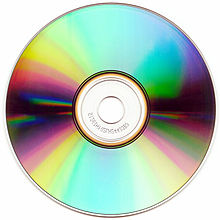
Back قرص صوت رقمي مضغوط Arabic Audio-CD Byelorussian CD Àudio Catalan Red Book Czech Compact Disc Digital Audio German CD audio Spanish سیدی صوتی Persian Red Book (norme CD audio) French CD de son Galician Zvučni CD Croatian
 | |
 | |
| Media type | Optical disc |
|---|---|
| Encoding | 2 channels of LPCM audio, each signed 16-bit values sampled at 44100 Hz |
| Capacity | up to 74–80 minutes (up to 24 minutes for mini 8 cm CD) |
| Read mechanism | Semiconductor laser (780 nm wavelength) |
| Standard | IEC 60908 |
| Developed by | Sony & Philips |
| Usage | Audio storage |
| Extended to | DVD-Audio |
| Released | 1982 |
| Optical discs |
|---|
Compact Disc Digital Audio (CDDA or CD-DA), also known as Digital Audio Compact Disc or simply as Audio CD, is the standard format for audio compact discs. The standard is defined in the Red Book, one of a series of Rainbow Books (named for their binding colors) that contain the technical specifications for all CD formats. CDDA utilises pulse-code modulation (PCM) and uses a 44,100 Hz sampling frequency and 16-bit resolution, and stores up to 80 minutes of stereo audio per disc.
The first commercially available audio CD player, the Sony CDP-101, was released in October 1982 in Japan. The format gained worldwide acceptance in 1983–84, selling more than a million CD players in those two years, to play 22.5 million discs.[1] In the music industry, audio CDs have been generally sold as either a CD single (now largely dormant), or as full-length albums, the latter of which has been more commonplace since the 2000s.[2]
Beginning in the 2000s, CDs were increasingly being replaced by other forms of digital storage and distribution, with the result that by 2010 the number of audio CDs being sold in the U.S. had dropped about 50% from their peak; however, they remained one of the primary distribution methods for the music industry.[3] In the 2010s, revenues from digital music services, such as iTunes, Spotify, and YouTube, matched those from physical format sales for the first time.[4] According to the RIAA's midyear report in 2020, phonograph record revenues surpassed those of CDs in the U.S. for the first time since the 1980s,[5][6] whereas in Japan the CD remains the premier music format and revenues have grown in 2022,[7] and in Germany it outsold other physical formats at least fourfold in 2022.[8]
- ^ Pohlmann, Ken C. (2000). Principles of Digital Audio. McGraw-Hill. p. 244. ISBN 978-0-07-134819-5.
- ^ "1999: The Year the Record Industry Lost Control". theafterword.co.uk. Retrieved 3 May 2024.
- ^ Plambeck, Joseph (30 May 2010). "As CD Sales Wane, Music Retailers Diversify". The New York Times. Archived from the original on 1 May 2017.
- ^ "IFPI publishes Digital Music Report 2015". 14 April 2015. Archived from the original on 14 April 2015. Retrieved 1 July 2016.
- ^ "Vinyl Outsells CDs For the First Time in Decades". 10 September 2020. Archived from the original on 22 September 2020. Retrieved 22 September 2020.
- ^ "Mid-Year 2020 RIAA Revenue Statistics" (PDF). Riaa.com. Archived (PDF) from the original on 9 May 2023. Retrieved 2 June 2023.
- ^ "3 observations on… how Japan's music industry caters to (and relies on) 'superfans' more than any other market". Music Business Worldwide. 23 October 2023. Retrieved 3 May 2024.
- ^ "Statistik | Absatz von physischen Tonträgern und digitalen Musikprodukten". miz.org (in German). Retrieved 3 May 2024.
© MMXXIII Rich X Search. We shall prevail. All rights reserved. Rich X Search